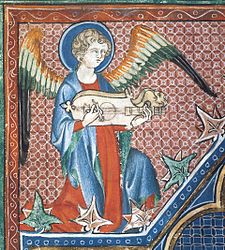Cytole

An angel as a citoler (citole player) in the English Psalter of Robert De Lisle, c. 1310.
|
|
| String instrument | |
|---|---|
| Classification | Plucked string instrument |
| Hornbostel–Sachs classification |
321.322-6 (box-necked lute) (Chordophone with permanently attached resonator and neck, sounded by a plectrum) |
| Developed | 13th-14th Centuries from the cithara (lyre), plucked fiddles and/or lutes |
| Related instruments | |
|
Bowed Plucked |
|
Bowed
Plucked
The Citole, also spelled Sytole, Cytiole, Gytolle, was a string musical instrument, closely associated with the medieval fiddles (viol, vielle, gigue) and commonly used from 1200—1350 Like the modern guitar, it was manipulated at the neck to get different notes, and picked or strummed with a plectrum (the citole's was long, thick, straight and likely made of ivory or wood). Although it was largely out of use by the late 14th century, the Italians "re-introduced it in modified form" in the 16th Century as the cetra (cittern in English), and it was possibly ancestral to the guitar as well. It was also a pioneering instrument in England, introducing the populace to necked, plucked instruments, giving people the concepts needed to quickly switch to the newly arriving lutes and gitterns.
It is known today mainly from art and literary sources. Early examples include Provençal poetry (there called the citola) from the 12th Century; however it was more widely displayed in medieval artwork during the 13th and 14th Centuries in manuscript miniatures and in sculpture. The art did not show uniformly shaped instrument, but instead an instrument with numerous variations. The variety shown in art has led the instrument to be called "ambiguous". From the artwork, scholars know that it was generally a four-string instrument, and could have anything from a "holly-leaf" to a rounded guitar shaped body (that can be called a "T-shaped" body). While paintings and sculpture exist, only one instrument has survived the centuries.
The sole survivor, associated with Warwick Castle, was made around 1290–1300. It is now preserved in the British Museum's collection. At some point, probably in the sixteenth century, it was converted into a violin-type instrument with a tall bridge, 'f'-holes and angled fingerboard; thus, the instrument's top is not representative of its original appearance. That instrument contributed to a great deal of confusion. It was labeled a violin in the 18th century, a gittern in the early 20th century and finally a citole, beginning after 1977. That confusion is itself illustrative of the confusion about the nature of citoles and gitterns; once the instruments and their traditions were gone, scholars in later centuries didn't know which images and sculpture went with which names from poetry and other literature. Additionally, scholars have translated passages in such a way that literature itself can not always be trusted. One example cited by the 1911 Encyclopædia Britannica: a specific reference to the citole may be found in Wycliffe's Bible (1360) in 2 Samuel vi. 5: "Harpis and sitols and tympane". However, the Authorized Version has psaltiries, and the Vulgate lyrae. The Britannica also supposed that the citole has been supposed to be another name for the psaltery, a box-shaped instrument often seen in the illuminated missals of the Middle Ages, also liable to confusion with the gittern. Whether the terms overlapped in medieval usage has been the subject of modern controversy. The controversy of citole versus gittern was largely resolved in a 1977 article by Lawrence Wright, called The Medieval Gittern and Citole: A Case of Mistaken Identity.
...
Wikipedia
